Why do dogs wag their tails?
Estimated 0 min read

Dog wagging tail
Have you ever wondered what your dog is trying to tell you when they wag their tail?
It turns out, there’s more to this common canine behavior than meets the eye.
But to truly understand your dog, you’ll need to look beyond the tail and consider the bigger picture.
In this exploration of canine body language, we’ll uncover the fascinating science behind tail wagging and reveal how you can use this knowledge to strengthen your bond with your pup.
Why do dogs wag their tails?
Tail wagging is a complex form of canine communication that conveys a range of emotions, with the position, speed, and direction of the wag providing nuanced insights into a dog’s emotional state. However, to fully understand what a dog is communicating, it’s crucial to consider other body language cues such as ear position, facial expressions, and overall posture in conjunction with tail wagging, as focusing solely on the tail may lead to misinterpretation of the dog’s intentions.
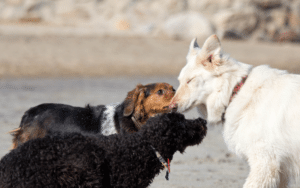
Dog greeting each other
The Purpose of Tail Wagging
Much like a human smile or a friendly nod, a wagging tail is often a polite greeting. It signals your pup is happy to see you or another dog. However, the message behind a wag can be more nuanced than a simple “hello.” Dogs use their tails to convey complex information about their emotional state and intentions.
When two dogs meet, they rely heavily on tail wagging to communicate and establish social relationships. Interestingly, the length of a dog’s tail can affect how easily its signals are interpreted by other dogs. Studies show dogs find it easier to decipher cues from longer tails and tend to respond more favorably to them. On the flip side, dogs with shorter tails may be more prone to misunderstandings and aggressive encounters, as their intentions can be harder to read.
The Science Behind Tail Wagging
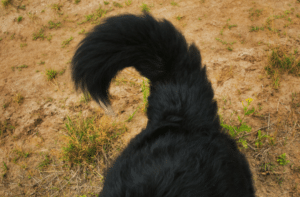
Wagging tails can give insight to Dog’s Mood
Tail Position
Just like a wagging tail doesn’t always mean a happy dog, the position of your pup’s tail can tell you a lot about its emotional state. Think of your dog’s tail as a mood barometer, with different positions indicating different feelings.
When your dog’s tail is held high and proud, it’s often a sign of confidence and alertness. This is the equivalent of a dog standing tall and saying, “I’m feeling great and ready to take on the world!” A high tail can also indicate a positive, friendly demeanor, especially when accompanied by a relaxed body posture and a soft, open mouth.
On the other hand, a tail held at a medium height, roughly parallel to the ground, can suggest that your dog is feeling curious or interested in its surroundings. This is the canine version of a raised eyebrow, as if your dog is saying, “Hey, what’s going on over there? I’d like to investigate!”
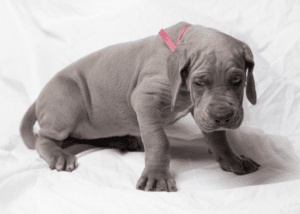
Tail tuck means uneasy dog
Now, if you see your dog’s tail lowered or even tucked between its legs, it’s time to pay attention. This tail position is often a sign of submission, fear, or stress, and it’s your dog’s way of communicating that it’s feeling vulnerable or unsure. In this situation, it’s best to give your pup some space and avoid any sudden movements or loud noises that could further startle or frighten them.
But what’s the science behind these different tail positions? As it turns out, the position of your dog’s tail is controlled by a complex network of muscles and nerves, all of which are influenced by the brain’s emotional centers. When your dog feels happy and confident, the brain sends signals to the tail muscles to raise the tail high, while feelings of fear or submission trigger the muscles to lower the tail.
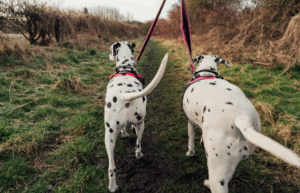
Happy hiking dogs
Speed and Direction of the Wag
The subtle variations in the speed and direction of tail wagging can provide even more nuanced insights into your dog’s emotional state.
A slow, tentative wag often indicates that your dog is feeling uncertain or insecure about a situation. It’s like your pup saying, “I’m not quite sure what to make of this, so I’ll proceed with caution.” This type of wag is often accompanied by a slightly lowered tail position and a hesitant body posture.
On the other hand, an energetic, rapid wag from side to side is usually a sign of excitement and enthusiasm. This is the tail equivalent of a big, friendly smile, and it’s often seen when dogs greet their favorite people or other canine friends. If your dog’s whole body is wiggling, you know you’ve got one happy pup on your hands!
But the speed of the wag isn’t the only factor to consider. Recent research has shown that the direction of the wag can also provide clues about your dog’s emotional state. It all comes down to the fascinating world of brain lateralization.
Studies have found that dogs wag their tails more to the right when they’re feeling relaxed and happy. In contrast, a wag that’s more to the left can indicate your dog is feeling alert, stressed, or anxious.
These fascinating insights have been made possible by advances in our understanding of the brain’s neural pathways. The motor cortex, located in the cerebral cortex, sends signals down the spinal cord to muscles that control tail movement. The right motor cortex controls the left side of the body, and vice versa. This allows us to interpret the emotional significance of left-sided and right-sided wags.
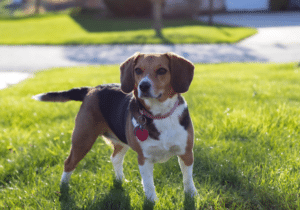
Curious Dog
Importance of Considering Other Body Language Cues
While tail wagging is undoubtedly a key aspect of your dog’s communication toolkit, it’s important to remember that it’s just one piece of the puzzle. Think of your dog’s body as a complex tapestry of signals, with each element contributing to the overall message. By focusing solely on the tail, you might miss important nuances or even misinterpret your dog’s intentions entirely.
For example, a wagging tail accompanied by a relaxed mouth and floppy ears is a sign of a friendly dog. But if that wagging tail is paired with a tense body posture, a closed mouth, and ears pulled back, your dog might feel anxious or uncertain, despite the seemingly “happy” wag.
Similarly, a still tail doesn’t always mean that your dog is feeling neutral or disinterested. If the tail is high and stiff while your dog is leaning forward, it could be a sign of aggression.
The eyes are another crucial piece of the body language puzzle. A soft, relaxed gaze with squinty eyes is a sign of a content, friendly dog. Meanwhile a hard, direct stare with a tense facial expression can indicate aggression or a challenge. Averted eyes or a lowered head, on the other hand, can signal fear, submission, or a desire to avoid conflict.
Even the way your dog is holding their weight can provide valuable clues about their emotional state. A dog that’s leaning forward with their weight on their front legs is often feeling confident and curious. However, a dog that’s leaning back with their weight on their hind legs may be feeling hesitant or unsure.
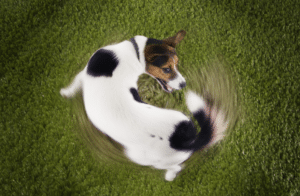
Happy dog chasing their tail
Conclusion
By learning to read these cues along with tail wagging, you’ll develop a much better understanding of your dog’s emotions. It’s like learning a new language – at first, it might seem daunting, but with practice, you’ll soon become fluent.
As we’ve seen, the world of canine communication is a fascinating and complex one, with tail wagging serving as just one of the many ways our furry friends express themselves. By learning to interpret these signals and considering them in the context of the whole body, we can deepen our understanding of our dogs and strengthen the bond we share with them.
But understanding your dog’s communication is just the first step in ensuring their overall well-being. At Banixx, we’re committed to providing you with the knowledge and resources you need to keep your canine companion happy, healthy, and thriving. Fromnutritionand exercise tips to guidance on commonhealth issues like psoriasisand behavior challenge, we’re here to support you every step of the way on your journey as a dog owner. So, keep exploring, keep learning, and most importantly, keep loving your furry friend – and don’t forget to check back with Banixx for more insights and advice on all things dog-related!
Sources
https://arete.ateneo.edu/assets/site/02-Why-Dogs-Wag-Their-Tails-Full-Text.pdf
https://vetmed.arizona.edu/news/media-why-dogs-wag-their-tails
https://vetmed.iastate.edu/story/wagging-his-tail
https://royalsocietypublishing.org/doi/10.1098/rsbl.2023.0407


















